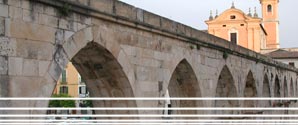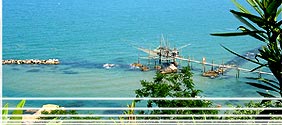The Saint's life:
Peter from Morrone was born in 1209 (1215?)
in Terra di Lavoro (Molise) from Angelerio
and Maria Leone, as it is stated in the
Papal Bull by Clemente V, dating back to
1306. When he was twenty, he left the Benedictine
Monastery of St Maria in Faifoli, where
he spent a short but unhappy time, looking
for absolute solitude. First he lived inside
a cave at Scontrone, in Castel di Sangro,
for a short time; then he spent three years
in a cave, dug in the rock by himself, on
Mount Palleno (today it is called Mount
Porrara).
Later a sanctuary -
St
Maria dell'Altare - will be
built there. He stayed there for a long
time, living in absolute solitude. After
that he went to Rome, stayed at the Laterano
and received holy orders.
In 1241 he left Rome. He retired in a cave
near a small mountain church devoted to
St Maria di Segezzano, at the foot of Mount
Morrone, in Sulmona. Later the Monastery
of Santo Spirito will be built on it.
As word of his sanctity spread, thousands
of local young people were attracted by
that pious man who undertook several penitences.
They will be Celestine's disciples. Peter
was reserved and quiet. So he could not
stand the several and noisy visitors getting
to him everyday. He left Segezzano's hermitage
and retired on the Majella massif. He chose
Ripa Rossa as his first and inaccessible
refuge.
Celestine's next refuges were
St
Spirito on Majella, where crowds
of poor and sick pilgrims went on visiting
him, and
St
Bartolomeo in Legio and
St
Giovanni in Orfento. In the
mountains of the Majella massif Celestine's
fame increased above all in the years from
1246 to 1293.
In 1273 Celestine, who was sixty, walked
to Lyon - it was winter! - to avoid that
Gregorio X, who had called a Council, abolished
his Order. Celestine's enterprise was successful.
In those years Brother Pietro had the idea
of building the big
Basilica
of Collemaggio in L'Aquila.
It was consecrated on 25 August 1288, on
Baptist's Decapitation Day. In the meanwhile
he went on enlarging
the Morrone
monastery because lots of people
wanted to join him. The monastery became
the seat of the Order.
Peter from Morrone was such a strong disciple
of Christ's message of poverty that in June
1293 he retired in
St
Onofrio hermitage, where he
spent thirteen months in absolute solitude.
In that same time, King Carlo II D'Angiò
came to an agreement concerning Sicily's
return with the Aragonesi. But he needed
a Pope who ratified that agreement. So he
made Peter write a strange letter to the
cardinals. In the letter Peter threatened
that God would get angry if the cardinals
did not hurry to elect a new Pope. After
Pope Niccolò IV' s death the Church
was getting more and more corrupted and
the relationship between Church and State
were bad.
So the cardinals chose Peter, who was elected
Pope as Celestine V on 29 August
1294. After his election, Celestine
gave plenary indulgence to everyone. That
was an extraordinary event, as only a few
social classes enjoyed such a privilege
(since then believers celebrate the so-called
"
Perdonanza"
or "Pardoning" each year on 28
August: they go and visit the Basilica of
Collemaggio and enter it passing through
the Holy Pardon Door in order to purify
their souls).
Celestine left L'Aquila and went to Neaples.
From 29 August to 13 December 1294, insincere
and dishonest people exploited Celestine's
name and fame to make dirty businesses,
thus disgracing the Church name.
Celestine's name and fame to make dirty
businesses, thus disgracing the Church name.
Even though he was old and tired because
of a life of privation, Celestine could
not stand that. Therefore he renounced his
role, ignoring the threats of the Neapolitan
people, who assaulted him and raided his
humble shelter. It was a great day, the
day of his own and of the Church's redemption.
He protested against the eleven cardinals
of the Council and he renounced to be a
Pope (Celestine V renounced but did not
refuse his role. Dante knew the difference
between those two words very well. That
is why Celestine cannot be labelled as "the
one who refused because of his cowardice").
On 24 December, twelve days after Celestine's
renunciation, Benedetto Caetani was elected
Pope, thanks to Carlo D'Angiò's help,
and he was called Pope Bonifacio VIII. The
mutual understanding between the new Pope
and the King of Neaples caused troubles
to Celestine and his disciples.
On 1 January 1295 Celestine, hunted as a
dangerous criminal by Carlo D'Angiò's
and Bonifacio VIII's allied police, left
San Germano and first he got to his cell
on Mount Morrone and then to Puglia. There
he tried to sail to Greece.
In Vieste he was seized by Bonifacio VIII's
emissaries and was confined into the fortress
of Castel Fumone. After three hundred and
nineteen years of hard imprisonment, the
old hermit died. It was Saturday 19 May
1296.


